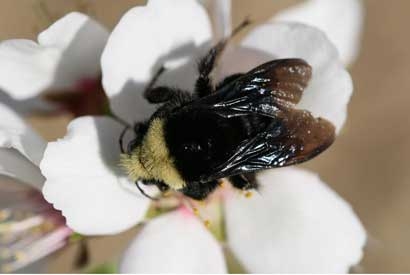As it turns out, the farmer and the cowman should be friends, as the classic “Oklahoma!” song suggests. According to a just-published UC Berkeley study, wild bee species pollinate California crops to the tune of $937 million to $2.4 billion per year. That amounts to more than one-third of all pollination “services” to the state’s crops.
Many of those crop-pollinating wild bees live in rangelands – chiefly ranches that graze cattle.
“This means that preserving rangelands has significant economic value, not only to the ranchers who graze their cattle there, but also to farmers who need the pollinators,” said Claire Kremen, UC Berkeley associate professor of environmental science, policy and management, and senior author of the study.
The assumption that wild pollinators were not a significant source of crop pollination is more than just conventional wisdom – it’s business: a majority of farmers rent European honeybees to ensure crop pollination.
But beekeepers have suffered high rates of colony losses due to diseases, pesticides and management factors, increasing the uncertainty of both supply and rental prices.

And wild pollinator species have also shown declines in abundance and diversity on farmlands, most likely due to habitat loss from the intensive monoculture, or single crop, production system that typifies much of California’s agricultural lands.
The result? They are most scarce precisely where they are needed the most.
“Currently, wild pollinators are least abundant in intensive monoculture production areas such as sunflowers, almonds and melons, where demand for pollination services is largest,” said Kremen.
Kremen equated depending mainly on one species – the European honeybee – with putting all our retirement savings in one stock.
“The wisdom of diversification holds true for agriculture as well and yet, many Calfornia farmers rely solely on European honeybees for crop pollination,” Kremen said, adding that the unpredictability associated with climate change amplifies the importance of diversification.
“Some insect species will thrive in changed climate conditions, and other won’t. Maintaining a biodiverse stock of pollinators is like the insurance that a diversified stock portfolio brings: some will be up, some will be down, but having a portfolio of many different species ensures viability into the future,” Kremen said.
While it’s common sense that healthy crops result in a healthy food supply, a separate study led by Kremen, also just published, put a number on the human health benefit of ensuring the viability of pollinators. The researchers estimated that up to 40 percent of some essential nutrients provided by fruits and vegetables could be lost if there were no pollinators around to do the job.
Payment for services rendered
Placing a value on ecosystem services is an established part of conservation science, and this new finding comes at a time when there is growing interest within the ranching community in providing ecosystem services. For example, as part of conservation efforts, California ranchers have been asked to maintain flowers for endangered butterflies and to keep small spring wetlands known as vernal pools healthy – using grazing as a tool to manipulate the grassland.
Darrel Sweet, a fifth generation cattle rancher from Livermore and a former president of the California Cattlemen's Association, said that placing a dollar value on rangelands pollination services lends powerful support to these efforts.
“The value of grazing and other land stewardship practices of California’s ranchers is being increasingly acknowledged as not only a preferred land use, but also as an essential resource management tool,” said Sweet. “I hope this study is just the beginning of comparable findings that show how ranching is a critical – and multifaceted – element of California agriculture.”
The state’s rangelands have been decreasing steadily, as the foothills and oak-dotted grasslands can be highly desirable for residential development. California lost 105,000 acres of grazing lands to urbanization between 1990 and 2004, according to the state Department of Conservation. The California Oak Foundation projects that the state could lose another 750,000 acres by 2040.
Kremen said the findings suggest that if farmers paid ranchers to stay on the land and maintain the habitat, the farmers would be increasing their sources of pollination and developing critical diversification to support their agricultural practices.